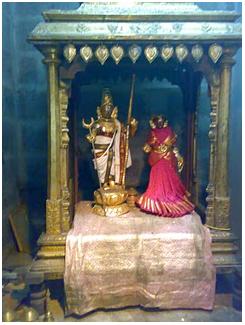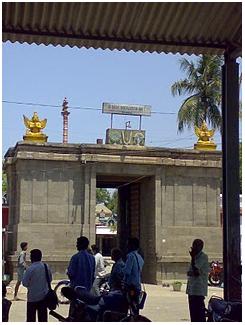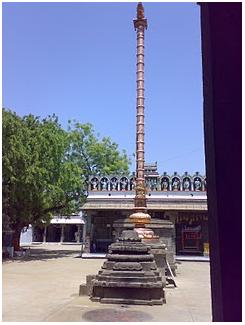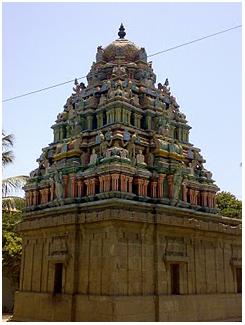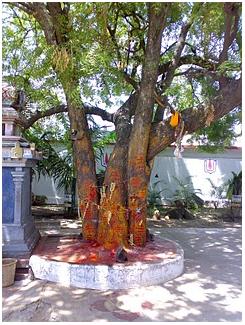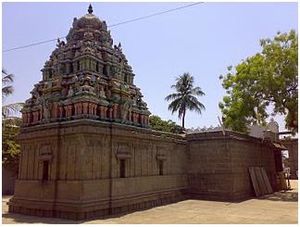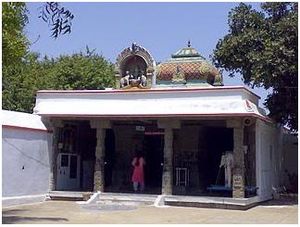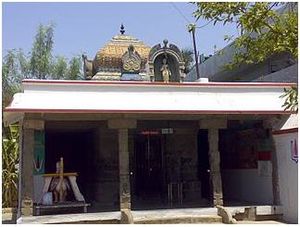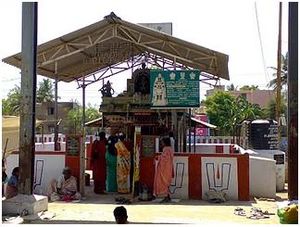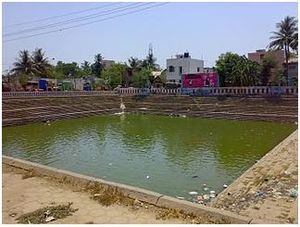Talk:Koyambedu Sri Vaikundavaasa Perumaal
Koyambedu is situated at the north western side of Chennai. An ancient temple for Lord Vishnu is located in Koyambedu where the main deity is Sri Vaikundavaasa Perumaal and Goddess Sri Kanagavalli Thaayaar. This temple lies adjacent to Sri Kurungaaleeswarar temple and both forming twin temples in Koyambedu.
It is also said that the names of this place in ancient days were as Kosai Nagar, Koyattipuram and Prayachithapuram. Kulothunga Chozha is said to have ruled in the 12th Century and hence it is said that the temple was constructed during his period.
It is said that Lava and Kusa, sons of Sri Rama stayed with Sage Valmiki in his Ashram here, along with their mother Sita Devi. It is said that Sri Vaikundavaasa Perumaal here was worshipped by Sage Valmiki, Lava and Kusa.
Usually, Vaikunda Perumaal temples will have the presiding deity in sitting posture. But here Perumaal is seen in standing posture along with Sri Devi and Bhu Devi.
This temple is also famous for its shrine for Sri Rama and Sita Devi. Sri Rama and Sita are found just outside the sanctum unusually on normal clothing instead of being dressed like King and Queen. Sita Devi is seen on a regular Saree with her hair do (called Kodaali Kondai) as an ordinary woman. It is made to signify their posture when they spent 14 years in the forest.
In another place, Sita Devi is also seen as a pregnant woman, as She gave birth to Lava and Kusa at Sage Valmiki’s Ashram, after She was exiled to forest. Goddess Sri Kanagavalli Thaayaar is present in a separate shrine on the outer praakaaram at the southwest side of the temple. Goddess is so beautiful, decorated with all Her ornaments. Sri Aandaal shrine is located at the northwest corner of the temple.
There are 3 trees uniquely grown very close to each other. There is one Vilvam tree between 2 neem trees on its either sides. It is said that Vilvam signifies Lord Shiva and one of the Neem tree represents Sri Parvathi and another Neem tree signifies Her brother Lord Vishnu. It is believed that it is like the wedding posture of Lord Shiva where Lord Vishnu presides over their marriage by joining their hands together. A Vilvam and Neem tree inside a Vaishnavite temple is a very rare sight.
There is a separate shrine for Sri Anjaneyar at the opposite side of the temple, where Sri Anjaneyar is seen facing west towards the temple. The theertham for this temple is ‘Lava Kusa Theertham’ which is believed to have been created by the two sons of Sri Rama. The same tank serves as Theertham for Sri Kurungaaleeswarar temple, which lies just adjacent to this temple.
There are many beautiful sculptures all around the temple.Koyambedu, apart from CMBT has these great twin temples, to form a divine pilgrimage center

